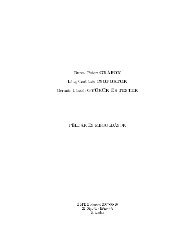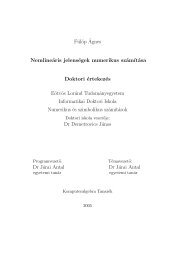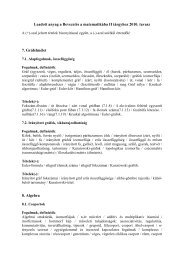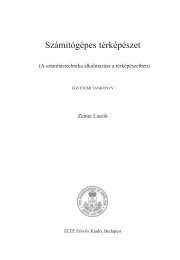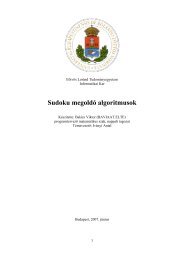On Erd˝os-Gallai and Havel-Hakimi algorithms
On Erd˝os-Gallai and Havel-Hakimi algorithms
On Erd˝os-Gallai and Havel-Hakimi algorithms
You also want an ePaper? Increase the reach of your titles
YUMPU automatically turns print PDFs into web optimized ePapers that Google loves.
8 A. Iványi, L. Lucz, T. F. Móri, P. Sótér<br />
03 Ti = Hn − Hi<br />
04 if Hj > i(i − 1) + Ti<br />
05 L = False<br />
06 return L<br />
07 L = True<br />
08 return L<br />
The running time of this algorithm is Θ(n) in worst case, while in best case<br />
is only Θ(1).<br />
According to our simulation experiments Binomial-Test is an effective<br />
filtering test (see 2) <strong>and</strong> 8).<br />
3.3 Splitting of the head<br />
We can get a better estimation of the inner capacity of the head, than the<br />
binomial coefficient gives in (3), if we split the head into two parts. Let ⌊i/2⌋ =<br />
hi, p the number of positive elements of b. Then the sequence (b1, . . . , bhi )<br />
is called the beginning of the head belonging to index i <strong>and</strong> the sequence<br />
(bhi+1, . . . , bi) the end of the head belonging to index i.<br />
Lemma 4 If n ≥ 1 <strong>and</strong> b is an n-graphical sequence, then<br />
further<br />
Hi ≤ min(min(Hhi , Tn − Ti, hi(n − i))<br />
+ min(Hi − Hhi , Tn − Ti, (i − hi)(n − i)), Ti)<br />
<br />
hi i − hi<br />
+ min(hi(i − hi) + +<br />
(i = 1, . . . , n), (4)<br />
2 2<br />
min(Hhi , Tn − Ti, hi(n − i)) + min(Hi − Hhi , Tn − Ti, (i − hi)(n − i)) ≤ Ti. (5)<br />
Proof. Let G be a simple graph whose degree sequence is b. Then we divide<br />
the set of the edges of the head belonging to index i into five subsets: (Si,1)<br />
contains the edges between the beginning of the head <strong>and</strong> the tail, (Si,2) the<br />
edges between the end of the head <strong>and</strong> the tail, Si,3 the edges between the parts<br />
of the head, Si,4 the edges in the beginning of the head <strong>and</strong> Si,5 the edges in<br />
the end of the head. Let us denote the number of edges in these subsets by<br />
Xi,1, . . . , Xi,5.<br />
Xi,1 is at most the sum Hhi of the elements of the head, at most the sum<br />
Tn − Ti of the elements of the tail, <strong>and</strong> at most the product hi(n − i) of the



